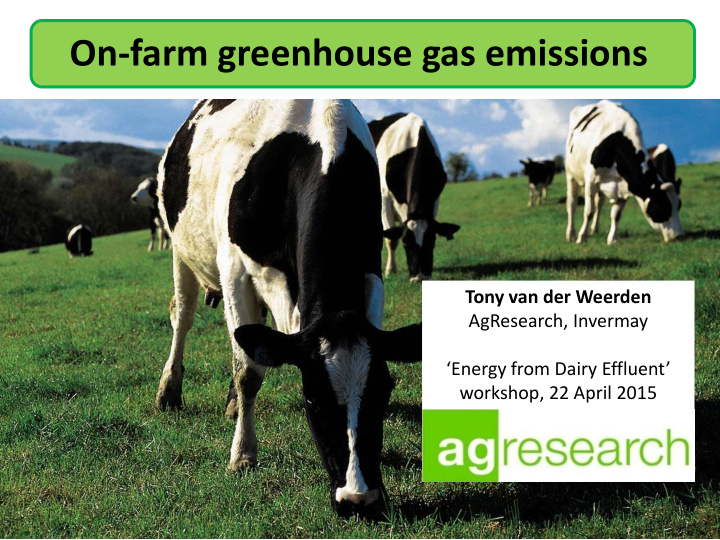



On-farm greenhouse gas emissions Tony van der Weerden AgResearch, Invermay ‘Energy from Dairy Effluent’ workshop, 22 April 2015
NZ’s GHG profile Proportion from each sector (2012) Agriculture 7% 5% 46% Energy 42% Industrial processes Waste NZ: unique profile - agriculture dominant source Gross emissions: 70,000 Gg CO 2 -e Net emissions: 49,500 Gg CO 2 -e (due to CO 2 removal by forests) (Ireland closest profile: ~33% from agriculture) Source: NZ’s GHG Inventory. MfE, 2014
Not all greenhouse gases are equal... Gas Global warming potential Carbon dioxide (CO 2 ) 1 Methane (CH 4 ) 25 Nitrous oxide (N 2 O) 298 One kg of methane is 25 times as potent as one kg of carbon dioxide, or 1 kg CH 4 = 25 kg CO 2 equivalents
NZ’s GHG profile Proportion from each sector (2012) Agriculture 7% 5% 46% Energy 42% Industrial processes Waste NZ: unique profile - agriculture dominant source Gross emissions: 70,000 Gg CO 2 -e Net emissions: 49,500 Gg CO 2 -e (due to CO 2 removal by forests) (Ireland closest profile: ~33% from agriculture) Source: NZ’s GHG Inventory. MfE, 2014
GHG by sector Source: NZ’s GHG Inventory. MfE, 2014
Contribution of dairying: livestock numbers Increasing dairy cattle, decreasing sheep & beef 2012: 50% of agricultural GHG emissions from dairying Source: StatsNZ
GHG emissions from dairying Dominant gases & sources: Methane Nitrous oxide (CH 4 ) Nitrous Oxide (N 2 O) Methane 35% 65% Effluent to Effluent Dung N fertiliser soil 3% 2% 2% 25% Enteric 96% Grazing 72%
Methane
How is enteric fermentation methane produced? Volatile Fatty Acids production FEED Hydrogen Methane Rumen microbes=methanogens
How is enteric fermentation methane measured? SF6 technology Methane AgResearch Grasslands, Palmerston North Respiration chambers
Nitrous oxide
How is nitrous oxide produced? N 2 O Animal urine N 2 O Urea fertiliser Nitrification Denitrification Ammonium Nitrate Naturally occurring soil processes Soil bacteria and fungi convert nitrogen to N 2 O Enhanced by: - nitrogen inputs - wet or compacted soil conditions
Sources of GHG on a ‘typical’ dairy farms in Waikato & Southland Description Waikato Southland Effective farm area (ha) 180 300 Effluent block 27 65 Cows/ha 3.2 2.7 Kg MS/cow 420 350 Kg MS/ha 1344 945 N fertiliser kg N/ha 140 140
Sources of GHG on a ‘typical’ Waikato dairy farm Sources of GHG on average dairy farm e.g. Waikato, Southland Source: Overseer
Sources of GHG on a ‘typical’ Southland dairy farm Sources of GHG on average dairy farm e.g. Waikato, Southland Source: Overseer
Comparing Waikato & Southland dairy farms Waikato Southland GHG intensity: ratio of GHG emission and farm annual MS production. Good measure of a farm’s efficiency. Waikato 8.4 kg CO 2 -e/ kg MS Southland 9.3 kg CO 2 -e/ kg MS Source: Overseer
CH 4 mitigation options • Animal breeding – selection of low CH 4 emitters • Diet manipulation (increased dietary fat, brassicas) • Rumen manipulation (biological control, inhibitors, vaccines)
N 2 O mitigation options • Reducing dietary N (e.g. maize silage, tannins) • N urea fertiliser: reduced rate, better timing Improve N conversion efficiency in rumen ( N in • excreta, MS/cow) • Avoid grazing wet soils (feed-pads or housing)
Off- paddock facilities (slowly) on the rise…. Feed pads – 27% Stand-off pads – 22% Animal shelters – 2% Winter barns – <1% Luo et al., 2013 2004: Approx. 6% of dairy excreta deposited off-paddock 2015: more, but data not available on how much more
Drivers for increased use of off-paddock facilities Avoid grazing wet soils → reduce N 2 O emissions* Limiting N leaching → off -paddock an option. Protect soil structure, pasture production. Increasing dairy intensification - most common dairy system: 10-20% of feed as supplements. * Currently no incentive More off- paddock facilities……but costly.
SOIL MOISTURE: driver for treading damage and nitrous oxide emissions increase nitrous oxide emissions increase moisture content Compaction Pugging
N 2 O When to stand-off? N 2 O N 2 O ‘pollution swapping’ Effluent application Off-paddock facility Effluent ponds
Summary Agriculture is largest source of NZ GHG; dairying represents 50% of total ag emissions Dairy farms: Methane from enteric fermentation and Nitrous oxide from soils most important sources (~97% of total emissions) Most promising short-term mitigation options: - reduced dietary N, - improve N conversion efficiency, - selection of low CH 4 emitters
Recommend
More recommend